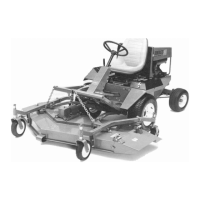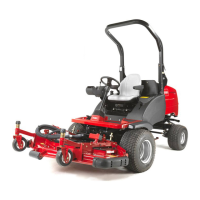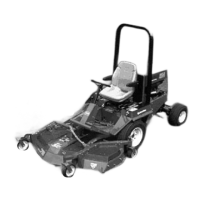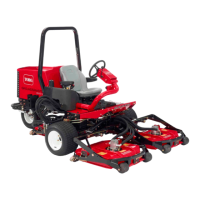TestProcedure(continued)
B.Atransmissiontractionreliefvalveorushingvalveisleakingor
damaged.
C.Thechargepumpinthetransmissionisdamaged(thePTOoperation
mayalsobeaffected).
10.Next,determinethechargepressureundertractionloadbyoperatingthe
machineinadirectforwardandreversedirection.Ensurethattheengineis
runningatfullspeed(3,000rpm).
Note:Whenapplyingbrakes,ensurethattheparkingbrakelatchisnot
pressed.Theenginewillstopiftheparkingbrakelatchispressed.
11.Firmlyapplythebrakesandpressthetractionpedalintheforwarddirection
andthentoreversewhileyoumonitorthepressuregauge.Releasethe
tractionpedaltoNEUTRAL,shutofftheengine,andrecordthetestresults.
A.Thechargepressureshouldnotdropmorethan15%fromtheinitialtest
reading(8)asthemachineismoving(e.g.,iftheinitialchargepressureis
830kPa(120psi),chargepressurewhilethemachineismovingshould
beabove700kPa(102psi).
B.Apressuredropofmorethan15%indicatesatractioncircuitleak(e.g.,a
leakingtransmissioncheckvalve,aworn/damagedtransmissionpiston
pump).Ifchargepressureisgoodundernoload,butthepressuredrops
belowspecicationwhenunderatractionload,thetransmissionpiston
pump(s)areprobablywornordamaged.
Note:Whenapistonpumpiswornordamaged,thechargepumpcannot
keepupwithinternalleakageinthetractioncircuit.
12.Stopthemachineandshutofftheengine.
13.Releasepressurefromthehydraulicsystem;refertoReleasingPressure
fromtheHydraulicSystem(page4–5).
14.Removethepressuregaugefromthetransmissioncharge-pressuretestport.
HydraulicSystem:TestingtheHydraulicSystem
Page4–44
Groundsmaster360
16225SLRevC

